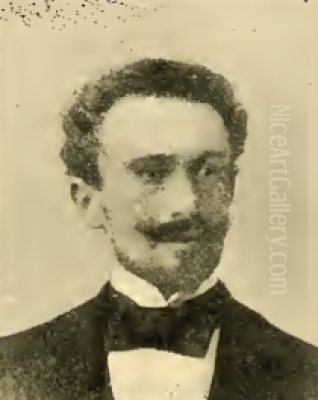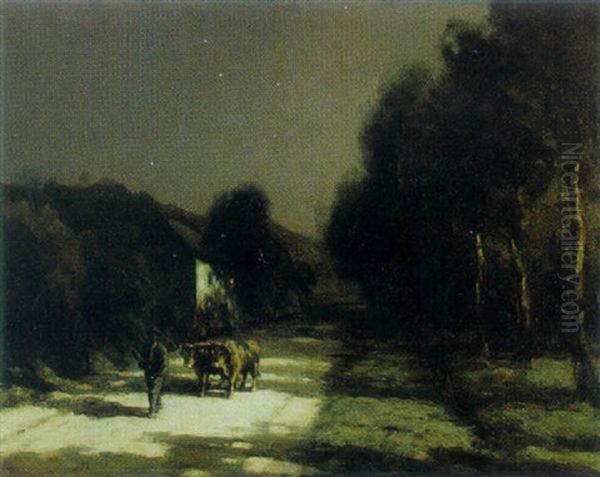
François Charles Cachoud (1866-1943) was a distinguished French painter celebrated for his evocative depictions of landscapes under the ethereal glow of moonlight. Born in the picturesque region of Savoie, France, Cachoud developed a unique artistic voice, dedicating much of his career to capturing the subtle nuances and poetic mystery of the nocturnal world. His works, often characterized by their dreamlike atmosphere and masterful use of light and shadow, hold a distinct place in the lineage of French landscape painting.
Early Life and Artistic Formation
François Charles Cachoud entered the world in 1866 in Chambéry, the historical capital of the Savoie region in the French Alps. This area, known for its stunning natural beauty, including dramatic mountains and serene lakes, would profoundly influence his artistic sensibilities and provide the primary backdrop for his most characteristic works. The landscapes of his youth became deeply ingrained in his visual memory, later re-emerging under the soft luminescence of the moon in his paintings.
Seeking formal artistic training, Cachoud made his way to Paris, the vibrant heart of the European art world. He enrolled in the prestigious École des Beaux-Arts, the leading institution for academic art instruction in France. There, he had the invaluable opportunity to study under prominent figures of the time. His mentors included Jules-Émile Delaunay, a respected painter known for his historical subjects and portraits within the Neoclassical tradition, and Gustave Moreau, a highly influential artist who became a central figure in the Symbolist movement.
This education provided Cachoud with a solid foundation in traditional techniques, including drawing, composition, and the handling of paint. Studying under masters like Delaunay exposed him to the rigors of academic precision, while Moreau's tutelage likely opened his eyes to the expressive potential of symbolism, mythology, and dreamlike imagery. This combination of influences – the academic discipline and the burgeoning Symbolist aesthetics – would contribute to the unique blend of realism and poetic atmosphere found in Cachoud's mature work.
The Allure of the Nocturne

While many of his contemporaries, particularly the Impressionists like Claude Monet and Camille Pissarro, were captivated by the fleeting effects of sunlight, Cachoud found his true calling in the quiet mystery of the night. He became a specialist in the nocturne, a genre focusing on scenes set at night or twilight. His particular fascination lay with moonlight, exploring its transformative power over familiar landscapes.
Cachoud developed a remarkable ability to render the subtle gradations of light and shadow that define a moonlit scene. He masterfully employed chiaroscuro, the dramatic use of contrast between light and dark, to create depth, volume, and a palpable sense of atmosphere. His moonlit landscapes are rarely stark or empty; instead, they are imbued with a soft, silvery light that seems to both conceal and reveal, lending an air of enchantment and tranquility to the depicted locations.
The appeal of the nocturne for Cachoud likely stemmed from its inherent romance and mystery. Nightfall transforms the everyday world, softening harsh outlines, deepening colours, and evoking a sense of introspection and peace. His paintings invite viewers into these quiet moments, offering a respite from the bustle of modern life and encouraging contemplation. The consistent focus on this theme allowed him to explore its variations with depth and sensitivity.
Savoie: A Landscape Bathed in Moonlight
Cachoud remained deeply connected to his native Savoie throughout his life, and the region served as the primary inspiration for his most iconic paintings. He frequently returned to depict the familiar lakes, villages, and rolling hillsides of his homeland, but always through the specific lens of moonlight. His works often feature locations like Lake Aiguebelette, capturing its reflective surface shimmering under the moon, or rural hamlets nestled peacefully in the nocturnal landscape.
He spent considerable time working from his home in Saint-Alban-les-Bains (now Saint-Alban-Leysse), near Chambéry. This allowed him direct and sustained access to the landscapes he loved, observing them under varying nocturnal conditions. His paintings are not mere topographical records; they are interpretations infused with personal feeling and a deep appreciation for the specific character of the Savoie region at night. The silvery blues, deep indigos, and occasional warm glows from cottage windows became hallmarks of his Savoie nocturnes.
His dedication to this specific geographical area, combined with his thematic focus, makes his work a unique visual ode to the Savoie region. He captured its soul not in the bright light of day, but in the quiet poetry of the night, revealing a different, more intimate aspect of its beauty.
Style, Technique, and Atmosphere

Cachoud's style is characterized by a blend of observational accuracy and poetic interpretation. While grounded in the reality of the landscape, his paintings transcend simple representation to evoke a specific mood, typically one of serenity, nostalgia, or gentle melancholy. His technique was refined, likely involving careful layering of glazes to achieve the subtle luminosity characteristic of moonlight.
His palette was dominated by cool tones – blues, greys, silvers, and deep greens – effectively conveying the nocturnal atmosphere. However, he often introduced points of warmer light, such as the glow from a window or the moon itself, creating focal points and adding a touch of human presence or celestial wonder. The overall effect is often described as dreamlike or magical, transporting the viewer to a world hushed and transformed by the night.
While working during the era of Post-Impressionism and the rise of Modernism, Cachoud largely maintained his distinct focus. His work shares some atmospheric kinship with Symbolist painters like his teacher Gustave Moreau or Odilon Redon, who also explored realms of dream and mystery. There might also be parallels drawn with the Tonalist movement (primarily American) or certain works by James McNeill Whistler, particularly his famous "Nocturnes," which similarly prioritized mood and atmosphere over precise detail. However, Cachoud's consistent dedication to the moonlit landscapes of Savoie gives his oeuvre a unique coherence.
Exhibitions, Recognition, and Key Works
Like most artists seeking recognition in his time, Cachoud participated in the official Paris Salons. He became a member of the Société des Artistes Français in 1889, regularly exhibiting his works at their prestigious annual Salon. This was the primary venue for artists to gain visibility, attract patrons, and build their reputations within the established art world. His consistent focus on nocturnes made his work recognizable amidst the diverse offerings of the Salons.
One of his most representative and celebrated works is Clair de lune sur le lac d’Aiguebelette (Moonlight on Lake Aiguebelette). This painting exemplifies his skill in capturing the reflective qualities of water under moonlight and the serene beauty of the Savoie landscape at night. It showcases his signature palette and his ability to create a deeply immersive atmosphere.
An anecdote highlights the personal connection within his work: a painting titled Clair de lune, exhibited at the Salon in 1929, reportedly depicted a scene inspired by an evening spent dancing under the moonlight with friends. This suggests how his personal experiences and appreciation for the simple joys of life under the night sky directly informed his art, adding a layer of lived reality to the romanticism of his chosen theme.
Cachoud in the Context of His Time
François Charles Cachoud navigated the French art scene during a period of significant change and diversification. He trained within the established academic system under Delaunay, a bastion of tradition, yet also absorbed the imaginative currents of Symbolism through Moreau. He worked concurrently with the later Impressionists, the Post-Impressionists like Vincent van Gogh (whose intense, emotionally charged Starry Night offers a stark contrast to Cachoud's calmer nocturnes), and the emerging Fauvist and Cubist movements led by artists such as Henri Matisse and Georges Rouault (fellow students under Moreau, though they took radically different paths).
While the avant-garde pushed boundaries, Cachoud carved out his own niche. His work can be seen alongside other French painters who explored twilight and nocturnal scenes with sensitivity, such as Henri Le Sidaner or Jean-Charles Cazin, though Cachoud's focus on moonlight was perhaps more singular. He maintained a connection to landscape traditions while infusing them with a specific, personal, and atmospheric vision. He did not align himself with the radical formal experiments of Modernism but continued to refine his chosen specialty, appealing to audiences who appreciated skillful representation combined with poetic sensibility. His path demonstrates the diversity within the art world, where artists could achieve recognition outside the main avant-garde movements by mastering a specific genre or theme. His work stands apart from the academicism of painters like Jean-Léon Gérôme, yet remains more representational than the Symbolist explorations of Redon.
Later Life and Enduring Legacy
François Charles Cachoud continued to paint throughout his life, remaining dedicated to the moonlit landscapes that had become his signature. His connection to the Savoie region endured, providing a constant source of inspiration. He passed away in 1943, leaving behind a substantial body of work focused on his unique vision of the night.
His legacy rests on his mastery of the nocturne and his evocative portrayal of the French Alps under moonlight. While perhaps not as widely known today as the leading figures of Impressionism or Modernism, Cachoud holds a respected position as a specialist painter who captured a particular aspect of nature with exceptional skill and sensitivity. His paintings offer a timeless appeal, inviting viewers into moments of quiet beauty and contemplation, illuminated by the soft, enchanting light of the moon. He remains celebrated as the "painter of moonlight," a title earned through decades of dedicated observation and artistic interpretation.
Conclusion
François Charles Cachoud carved a distinct and memorable path in French art history through his unwavering dedication to the nocturne. As the "painter of moonlight," he transformed the familiar landscapes of his native Savoie into scenes of poetic beauty and quiet mystery. His education at the École des Beaux-Arts provided a firm technical grounding, while his personal artistic vision led him to explore the subtle effects of chiaroscuro and the evocative power of the night. His works, exemplified by pieces like Clair de lune sur le lac d’Aiguebelette, continue to resonate with viewers seeking moments of tranquility and enchantment, securing his place as a master of atmospheric landscape painting.